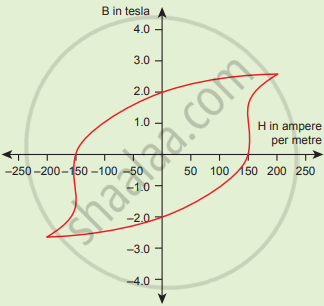Advertisements
Advertisements
प्रश्न
What is ferromagnetism?
Explain the following with suitable examples:
Ferromagnetism
उत्तर १
The substances that can be permanently magnetised even in the absence of a magnetic field are called ferromagnetic substances, and the mechanism is called ferromagnetism.
उत्तर २
The substances that are strongly attracted by a magnetic field are called ferromagnetic substances. Ferromagnetic substances can be permanently magnetised even in the absence of a magnetic field. Some examples of ferromagnetic substances are iron, cobalt, nickel, gadolinium, and CrO2.
In solid state, the metal ions of ferromagnetic substances are grouped together into small regions called domains, and each domain acts as a tiny magnet. In an unmagnetized piece of a ferromagnetic substance, the domains are randomly oriented, and so their magnetic moments get cancelled. However, when the substance is placed in a magnetic field, all the domains get oriented in the direction of the magnetic field. As a result, a strong magnetic effect is produced. This ordering of domains persists even after the removal of the magnetic field. Thus the ferromagnetic substance becomes a permanent magnet.

Schematic alignment of magnetic moments in ferromagnetic substances
APPEARS IN
संबंधित प्रश्न
Iron (z=26) is highly ferromagnetic. Explain.
What type of magnetism is shown by a substance if magnetic moments of domains are arranged in same direction?
Write the type of magnetism observed when the magnetic moments are oppositely aligned and cancel out each other.
Write the type of magnetism observed when the magnetic moments are aligned in parallel and anti-parallel directions in unequal numbers.
What type of substances would make better permanent magnets, ferromagnetic or ferrimagnetic. Justify your answer.
Explain the following with suitable examples: Paramagnetism
Explain the following with suitable examples: Ferrimagnetism
Explain the following with suitable examples: Antiferromagnetism
Give reasons:Ferrimagnetic substances show better magnetism than antiferromagnetic substances.
The complexion [Ni(CN)4]2- is:
Out of [CoF6]3- and [Co(en)3]3+, which one complex is
(i) paramagnetic
(ii) more stable
(iii) inner orbital complex and
(iv) high spin complex
(Atomic no. of Co = 27)
Give reason for the following :
Sulphur in vapour state shows paramagnetic behaviour.
The BH curve for a ferromagnetic material is shown in the figure. The material is placed inside a long solenoid which contains 1000 turns/cm. The current that should be passed in the solenonid to demagnetize the ferromagnet completely is

Give the properties of dia/para/ferromagnetic materials.
Compare the properties of soft and hard ferromagnetic materials.
Example of ferromagnetic substance is ____________.
Substances which are weakly repelled in magnetic field are known as ____________.
All those atoms or molecules which have an odd number of electrons are
Fe3O4 is ____________.
Which type of substances would make better permanent magnets?
Assertion: On heating ferromagnetic or ferrimagnetic substances, they become paramagnetic.
Reason: The electrons change their spin on heating.
Which of the following arrangements shows schematic alignment of magnetic moments of antiferromagnetic substances?
Which of the following statements is not true?
A ferromagnetic substance becomes a permanent magnet when it is placed in a magnetic field becuase ______.
The value of magnetic moment is zero in the case of antiferromagnetic substances because the domains:
(i) get oriented in the direction of the applied magnetic field.
(ii) get oriented opposite to the direction of the applied magnetic field.
(iii) are oppositely oriented with respect to each other without the application of magnetic field.
(iv) cancel out each other’s magnetic moment.
Which one of the following pairs has only paramagnetic species?
Some of the polar crystals when heated produces small electrical current. This phenomenon is called ______.
Given below are two statements labelled as Assertion (A) and Reason (R).
Assertion: Magnetic moment values of actinides are lesser than the theoretically predicted values.
Reason: Actinide elements are strongly paramagnetic.
Select the most appropriate answer from the options given below:
The correct order of bond strength is ______.
The susceptibility of a paramagnetic material is 99. The permeability of the material in Wb/A-m is ______.
[permeability of the free space μ0 = 4π × 10-7 Wb/A - m]
Among the following ions, which one has the highest paramagnetism?
Which one of the following compounds is diamagnetic and colourless?
The metal complex ion that is paramagnetic is ______.
(Atomic number of Fe = 26, Cu = 29, Co = 27 and Ni = 28)
